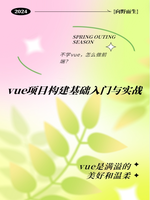2.4 函数的声明和定义
在TypeScript与Vue的联合开发中,函数作为代码的基本构建块,扮演着至关重要的角色。无论是处理数据逻辑、响应用户操作还是管理组件的生命周期,函数都是不可或缺的工具。本章节将深入探讨TypeScript中函数的声明与定义方式,以及这些概念如何与Vue框架相结合,提升开发效率和代码质量。
2.4.1 函数基础
在TypeScript(以及JavaScript)中,函数是一段可以重复使用的代码块,用于执行特定任务。函数可以接受输入(称为参数)并可能返回输出(称为返回值)。理解函数的声明和定义是掌握TypeScript编程的基础。
2.4.1.1 函数声明
函数声明是告诉编译器函数的存在及其签名(即参数类型和返回类型)的一种方式。在TypeScript中,函数声明遵循以下基本语法:
function functionName(parameter1: type1, parameter2: type2, ...): returnType {// 函数体}
- functionName:函数名,遵循标识符命名规则。
- parameter1, parameter2, …:函数参数,可以有一个或多个,每个参数后面都跟着其类型注解(type annotation)。
- returnType:函数返回值的类型。如果函数不返回任何值,则使用
void类型。
示例:
function greet(name: string): string {return `Hello, ${name}!`;}console.log(greet('Alice')); // 输出: Hello, Alice!
2.4.1.2 函数表达式
除了函数声明,TypeScript还支持函数表达式,它允许将函数赋值给变量或作为参数传递给其他函数。函数表达式通常使用箭头函数(Arrow Functions)语法,它提供了一种更简洁的方式来写函数。
箭头函数语法:
const functionName = (parameter1: type1, parameter2: type2, ...): returnType => {// 函数体};// 或简写形式(当函数体只有一行时)const functionName = (parameter1: type1, parameter2: type2, ...): returnType => expression;
示例:
const add = (a: number, b: number): number => a + b;console.log(add(2, 3)); // 输出: 5
箭头函数不仅语法简洁,更重要的是它们不绑定自己的this,arguments,super,或new.target。这些函数表达式更适合用于非方法函数,并且能很好地与TypeScript的类型系统结合。
2.4.2 函数类型注解
在TypeScript中,为函数参数和返回值添加类型注解是一种好习惯,它有助于在编译时捕获潜在的错误,提高代码的可读性和可维护性。
- 参数类型注解:明确指定每个参数的类型,确保传递给函数的值符合预期。
- 返回类型注解:指定函数返回值的类型,让调用者知道可以期待什么类型的值。
示例:
function createUser(name: string, age: number, isAdmin: boolean): User {return {name,age,isAdmin};}interface User {name: string;age: number;isAdmin: boolean;}const user = createUser('Bob', 30, true);console.log(user); // { name: 'Bob', age: 30, isAdmin: true }
2.4.3 函数重载
在TypeScript中,函数重载允许一个函数根据传入的参数数量或类型以不同的方式被调用。这通过为同一个函数名提供多个函数类型定义来实现,编译器会根据调用时提供的参数来解析对应的函数签名。
函数重载的基本语法:
function functionName(params1): returnType1;function functionName(params2): returnType2;function functionName(paramsN): returnTypeN {// 实现}
示例:
function add(a: number, b: number): number;function add(a: string, b: string): string;function add(a: any, b: any): any {if (typeof a === 'number' && typeof b === 'number') {return a + b;}if (typeof a === 'string' && typeof b === 'string') {return a.concat(b);}throw new Error('Unsupported types for add');}console.log(add(1, 2)); // 输出: 3console.log(add('hello', 'world')); // 输出: helloworld
注意,虽然上面的示例使用了any类型来简化实现,但在实际开发中,应尽量避免使用any,因为它会失去TypeScript提供的类型检查优势。
2.4.4 函数与Vue的结合
在Vue组件中,函数扮演着至关重要的角色,尤其是在处理用户交互、数据更新和组件生命周期等方面。Vue组件的方法(methods)本质上就是函数,它们可以在模板中被调用,也可以在组件的其他部分(如计算属性、侦听器或生命周期钩子)中被引用。
Vue组件中的方法示例:
<template><div><button @click="greet">Greet</button><p>{{ message }}</p></div></template><script lang="ts">import { Vue, Component } from 'vue-property-decorator';@Componentexport default class MyComponent extends Vue {message: string = '';greet() {this.message = 'Hello, Vue with TypeScript!';}}</script>
在这个例子中,greet方法是一个典型的Vue组件方法,它会在按钮被点击时调用,并更新组件的message数据属性。注意,这里使用了vue-property-decorator库来简化Vue组件的TypeScript声明,它允许我们使用类风格的组件定义和装饰器语法。
2.4.5 小结
函数的声明和定义是TypeScript编程的基础,也是Vue开发中不可或缺的一部分。通过为函数添加类型注解,我们可以利用TypeScript的强大类型系统来捕获潜在的错误,提高代码的可读性和可维护性。同时,Vue组件中的方法(即函数)是实现用户交互、数据更新和组件逻辑的关键。掌握函数的声明和定义,以及如何在Vue组件中有效地使用它们,对于开发高效、可维护的Vue应用至关重要。








